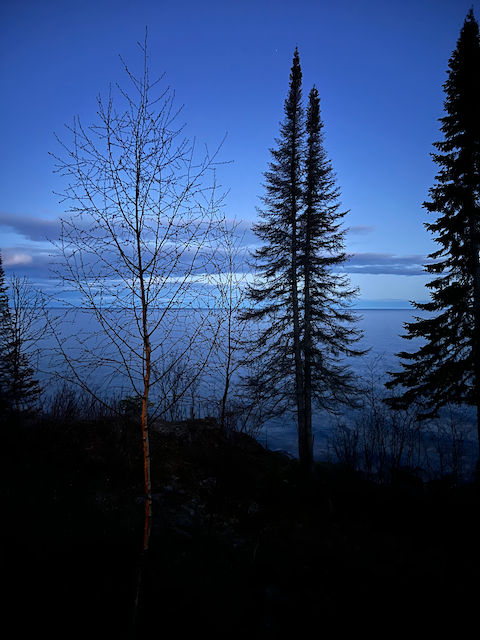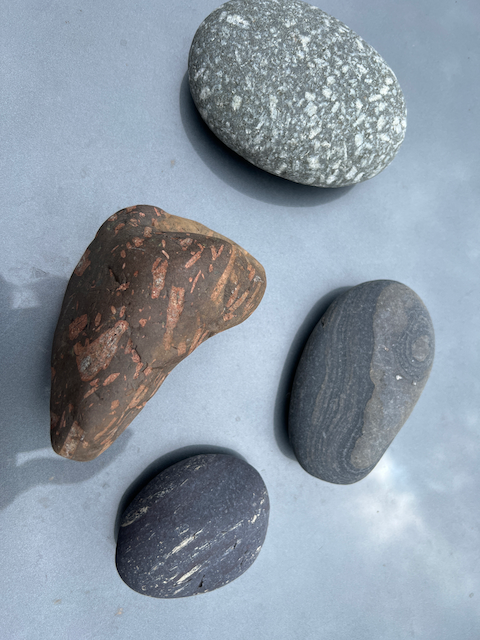Wednesday, 25 May 2022
Two weeks and change have passed, and here I am again.
The notable events for the last couple of weeks include ‘graduating’ from physical therapy, a trip to the north shore, and… well, I think not much else.
Huff huff
I continue to devote a lot of time to ‘prehabilitation,’ a vastly preferable alternative to rehabililitation. Regarding the latter, I’ve ‘graduated’ from my course of physical therapy for my elbow (tendon) and shoulder. While I still have occasional twinges in the elbow, they’ve grown rare, and I believe I understand how to modify my actions so as to avoid a recurrence of the problem. In what turned out to be my final meeting with the therapist, she measured my grip strength, which showed that my right arm was now slightly stronger than my left arm (95 / 90), whereas when I had first come in my grip strength was 60/90); she also did some more qualitative tests of my shoulder/arm stability, and pronounced me in good shape. We also culled my PT exercises to a more manageable number that I will make part of my regular routine, and she advised me to stretch to manage the morning soreness in my left achilles tendon. I am still getting into the habit of doing that, but I believe it is helping. With my PT-centric routine streamlined, I am adding in exercises that target my hips and arms, as well as continuing to work on elbow, core and thighs.
North Shore
We spent a week in Seagull House, a few miles north of Grand Marais on the north shore of Lake Superior. We went a couple hundred miles north, and about a month backwards in time, arriving to trees with buds just beginning inflate into a net of green cast across the bare branches. The temperatures were mostly in the 40’s, though it was sunny and quite a bit warmer in sheltered areas. After having intentions of maintaining a minimal schedule of my phone-based chats, I decided to cancel everything and cast myself loose of any external schedule. So K and I did our usual pattern of slow mornings, followed by a lunch and some kind of activity — usually walking or hiking — in the mid to late afternoon. We would either go to a restaurant for lunch, and come away with enough leftovers for dinner, or eat leftovers for lunch, and go to a restaurant for dinner and come away with leftovers for the next day.
The highlight of the trip was the rivers. We were just past ‘peak melt,’ if that is a term, and the rivers were near to overflowing (the previous week they had been overflowing). Here are some pictures of Cross river:

The night we arrived it was clear, and we’d read that there was going to be a blood moon, an eclipse during which the moon is lit only by light passing through the earth’s atmosphere making it a dim red. The eclipse was indeed beautiful and uncanny, but my camera was too ‘smart’ to capture the effect, preferring to brighten whatever it could from dim blood red to white; and I was too dumb to know how to tell it not too. The picture on the left is the view from our window at twilight, and the picture on the right is the blood moon, optimized for visibility by the camera. The view from the naked eye was of a dim rusty orb hovering next to a ghostly birch tree.


The days of our vacation unfolded one after the other, some warm and some less so, some sunny and some stormy. We carried on with our usual vacation activities – in addition to our outdoor venture – of reading, writing, running (me), and playing piano (me). I also gathered quite a few rocks.
Geology, Rocks, and Cobbles
Geology is one of the avocations I’ve taken up in retirement, and the north shore is a good place to pursue it. A billion years ago this area was the site of a massive rift — running hundreds of miles — in the continent (the called Laurentia), and lava poured fourth, intermittently, for a few tens (or perhaps hundreds) of million years. In the normal course of events, the continent would crack, and the lava from the rift would push the two pieces apart, and a sea would form in the middle. That did not occur, likely, so current theories tell us, because something else collided with the east coast of Laurentia and the ensuring pressure caused the rift to close. Nevertheless, the northern part of what is now the central US, as well as a buried rift valley extending down to at least Iowa, is a post-volcanic landscape that probably looked much as iceland does today.
What all this amounts two is that the north shore is the remnant of a volcanic landscape, layered with hundreds of lava flows, and also, after a billion years, with enough erosion having occurred to expose some of the plutonic rocks (magma that solidified below the surface), meaning that it cooled more slowly and had time to form visible crystals like those you see in granite, There are also occasional layers of sedimentary and metamorphic rocks. These formed during quiet interludes in the volcanism, when for a few million years rain and sun and wind had its way with rock, and produced sand and soil which in turn lithified into sandstone and shale, which turn, at least sometimes, metamorphosed into quartz and slate and other rocks. Once the rift finally sealed (or “failed” as geologists say), there were about 900 million years of weather and erosion to turn a lot of the rock back into sand and other sediments, to be washed down the ever shifting watersheds. (One thing to remember is that in the hundreds of millions of years before plants colonized the land, erosion happened very rapidly and with great magnitude; recall that the grand canyon is only 6 million years old — here we’re talking of a period of erosion over two orders of magnitude greater than that. At the very end of all this – in geologically modern times – the greatest erosive force of all, glaciers, rolled over the area and gouged and broke and moved unimaginable amounts of rock from the earth’s surface, moving it south, and finally, depositing a layer of rubble a kilometer or so deep over much of minnesota and areas at similar lattitudes.
All of these rocks, whether they are volcanic, plutonic, metamorphic, or sedimentary, can be found on the north shore, often in the form of curiously patterned cobbles. The ordinary person — excepting curious children – might not pay much attention, but the cobbles on the shore can tell stories to those with geological knowledge.
This brings us to my latest project. I like rocks, but am cautious about launching into collecting them at my stage in life, as ‘downsizing’ becomes less a term of theory, and more a practical matter bearing inexorably down on me. Collecting whatever pleases me seems a bad idea, as there is so very much I find of interest. However, I recently had the idea the collecting beach cobbles from the north shore would be a good way to impose some constraints on the collecting impulse. This became a more enticing idea recently, as a friend and I went in together on purchasing a lapidary saw and polisher. I like the idea of having a set of beach cobbles, each with one end sliced off and the flat surface polished so that it provides a view of the internal structure of the rock. Here are two pictures, one of a few cobbles, and another of a cross-section of one of them.


That’s it for now. Doubtless there will be more to come.
Views: 0